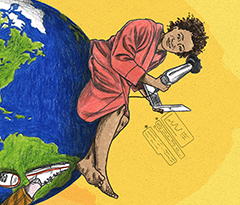3 Ways Hybrid Collaboration Can Bridge Both Space and Time
In a truly connected organization, people can communicate effectively no matter where they are—and no matter when they work

Same time, different place? Or different time, same place? Here’s how to help your people work seamlessly across time and space.
Illustration by David SparshottDownload the guide

A note on the WorkLab Guides:
Hybrid work is a work in progress—and no one has all the answers. At Microsoft, we take a learn-it-all approach, looking to the data and research where we can; talking to our customers; and learning from our own employees as well. We’ve informed these guides with as much data and research as possible. But there’s still much to learn—and we’re committed to share new insights and discoveries as we go.,
This guide covers asynchronous collaboration and how to unlock it.
Leaders have traditionally focused on helping people get work done in two main modes:
Collaborating with others at the same time (working synchronously)
Working independently (asynchronously)
Both of these kinds of work used to typically happen in the same place—the office.
The new reality : People now collaborate synchronously and asynchronously when they are physically apart—and the actual workday schedules might not be the same for everyone.
The need : Leaders have to consider two additional work “modes.” Here, we’ll unpack the four modes of hybrid work and how to unlock the full potential of each for your people and your organization.
The Four Modes of Hybrid Work
Historically, work happened either synchronously or asynchronously in the same location. In the hybrid world, two additional forms of work have emerged.

Three Steps to Optimize Meetings for Asynchronous Collaboration
Distribute meeting-related documents ahead of time, and ask for comments and ideas so participants can review on their own schedule.
Make the most of tools like Viva Insights , which helps people prep for meetings, find unread emails and documents, and get reminders about tasks and commitments. And the new app Microsoft Loop offers users a canvas with portable components that stay in sync across apps like Teams, Outlook, and OneNote, making it easier for people to stay up-to-date on project developments.
Be transparent to reduce the “fear of missing out” effect by recording meetings, and then make the recordings, slides, notes, and transcripts available to invitees so everyone can review key takeaways. Summaries and highlights will help non-attendees focus on the portions that are relevant to them. (Improvements in AI mean that meeting summarization tools will soon relieve humans of this task.)
As we’ve moved to hybrid models, people have customized their schedules for work-life balance and optimal productivity—in the first year of the pandemic, Microsoft recorded a 30 percent increase in employees doing work in the evenings . Leaders must create norms to avoid an “always on” culture that will lead to burnout. This starts with a healthy messaging culture.
MAKING THE MODE WORK:
Communicate (and Model) Boundaries
Encourage work-life boundaries by typing NOT URGENT, CAN BE ANSWERED TOMORROW in the subject line or at the top of a message. You can also add a note to your signature: “I don’t expect an immediate response.”
Model the Behavior
When leaders wait to send emails until working hours resume, they send the signal that it’s okay to disconnect.
Use Delay Features
You can use the delay-send option in Outlook or Delay delivery in Viva Insights to help minimize disruptions to recipients outside their working hours or when they’re away from work.
Switch Off Notifications
Some teams may prefer that the norm be to not use delay-send functionality and have people turn off notifications instead—that way they don’t have to wait until Monday morning to address an email they had a pocket of time to deal with on Sunday afternoon.
Share Your Status
Presence indicators let people know when you are available, busy, or away. Part of hybrid competence is understanding and being attentive to these signals.
Make sure everyone understands presence states in Microsoft Teams, and encourage people to use away messages to proactively communicate with colleagues.
How to Run the Synchronous Parts of Your Hybrid Meeting
Microsoft uses the mnemonic CHARMS to make sure all meeting participants know how the session is going to go.,
Encourage active positive participation in the chat; people should use it to ask and answer questions, and share relevant content like articles, documents, and reports.
Chat is also a great way for those who are less comfortable with speaking up to contribute.
Raise your hand (or use the hand-raise emoji) if you want to make a comment or pose a question verbally.
Have a clear purpose for the meeting and provide estimates of how long you expect to spend on each portion.
Align expectations at the top of the meeting so everyone knows how it’s going to be run.
Keep an eye on the clock and stick to agenda times.
Capture the meeting as a recording that can be transcribed later, and have a note taker jot down highlights. Make these available to all meeting participants as well as invitees who were unable to attend.
Designate a moderator to keep the conversation flowing, make sure that points that come up in the chat are surfaced, and pause in-room conversation to call on remote hand-raisers or solicit input from remote team members.
Orient everyone at the outset, so local participants know where the microphones are and remote participants know where the cameras and display screens are (even if they can’t see them).
Doing work at the same time but physically apart is the core hybrid experience. Teams can connect across town or across the globe through video calls, real-time chat, and virtual whiteboards .
MAKING THE MODE WORK:
Show People You’re Listening with Body Language
For a number of reasons, not everyone can be on camera all the time in meetings. But managers in particular should be aware of the importance of non-verbal cues to communication.
When you are on camera, you can convey to team members who are speaking that they have your full attention by having your whole upper body visible.
If participants see your hands, they know you aren’t fiddling with your phone.
Keep those 1:1 Connects Going
Research shows that one-on-one connects with managers are key to keeping people happy and engaged in flexible work models. So it’s more important than ever to schedule one-on-one time to ask about how people are doing, discuss obstacles, celebrate, and talk about growth opportunities.
It’s also helpful to enable casual chats—encourage employees to set aside blocks of time when people can grab them, wherever they are.
Onboarding Is Essential
In a hybrid world, empathetic, thorough onboarding is key, and a buddy system can help people feel welcome and productive.
In a 2021 survey by Glint and LinkedIn Market Research, nearly half of respondents (45 percent) identified “finding the information/resources to do [their] job” as a top source of stress during onboarding.
An employee experience platform like Microsoft Viva can help—it’s a way to connect new employees with repositories of institutional knowledge, educational modules, and actionable insights tailored directly to them.
The Future of Onboarding Is the Metaverse
Technology is opening up new opportunities for rich onboarding experiences designed for hybrid work.
Microsoft has collaborated with Accenture to create a virtual campus called the Nth Floor, which the consultancy has already used to welcome more than 150,000 employees.
Rule number one for navigating this metaverse environment: no walking through people’s avatars.
WorkLab’s 2022 Work Trend Index showed that, compared to two years ago, 59 percent of respondents in hybrid work environments and 56 percent of those who are entirely remote say they have fewer work friendships. As leaders encourage teams to return to the office, they should also be encouraging everyone to use that precious in-person time to strengthen connections with colleagues.
MAKING THE MODE WORK:
Prioritize What You Can’t Do Remotely
Line up meetings that are particularly well-suited for face-to-face interactions, like team building and bonding events and creative brainstorms .
Move Around Together
When it comes to in-person meetups, move around and do something different: maybe it’s regular coffee, drinks, or lunch; maybe walking meetings; or just hold a meeting in a spot you’ve never used before.
Step Out of Your Silo
If you bump into a new hire from a different department on your way to the kitchen, introduce yourself if you feel comfortable doing so.
Make Time for In-person Time
Remember that casual interactions take time. They may make time in the office seem a little less “efficient,” but the benefits to the entire team are worth it.
Plan Ahead for Big Gatherings
Look for ways to connect with remote employees in person as well— schedule on-sites on a regular basis, and at least twice a year.
Think Beyond HQ
Work with regional offices to ensure remote employees are making the most of in-person time. Consider co-working spaces in locations where you have a number of remote employees, and create social opportunities to bring them together.
Here’s how to get the most out of time in the office—even when colleagues’ schedules don’t align.
MAKING THE MODE WORK:
Most Meetings Are Still Digital Meetings
People coming back to the office won’t just be interacting with other people in the office. They will still be collaborating—in and out of meetings—with remote and hybrid co-workers, clients, and customers.
Set expectations and norms that encourage best hybrid-work practices .
Make sure that meeting rooms have the proper equipment, and set aside a few minutes to ensure that people who are not on-site have the best experience possible.
Teams meeting features like live captioning and transcription are vital for people with hearing impairments or who have issues processing conversations in real time, but they can also be useful to any team member who was momentarily distracted.
Build Smaller Spaces and Quiet Nooks
A desk in the middle of an open-floor office might not be the best place to do quiet focused work, or to have a spirited conversation with someone who’s not on-site.
Create spots around the office where employees won’t be disrupted and won’t disrupt others, including focus rooms and small meeting rooms for interacting with off-site people.
Aim for the Best of Both Worlds
Spending time in the office is great. But team members who actually can do their jobs remotely should be allowed to do their jobs remotely as much as team agreements permit.
Ensure that remote workers have the best possible remote experience, and that in-person workers have the best possible in-person experience.
Support People Who Need to Be On-site Too
Employees who need to be on-site, including many frontline workers, should benefit from more flexibility and predictability as well.
The best way to do that is to arm them with the tools and training they need to use automation to minimize rote tasks—so they can focus on more high-value work—and easily swap shifts and manage schedules , as well as maximize time spent collaborating with their co-workers.
Leaders should leap at the chance to help their teams make more effective use of their time spent working together—and their time spent working apart. It’s a win-win scenario for enabling personal flexibility while also unlocking great productivity for the organization. The key is to combine a growth mindset with an intentional approach to learn how different sorts of work can—and should—happen.